Home • Archives for Yana Popenkova
Yana Popenkova
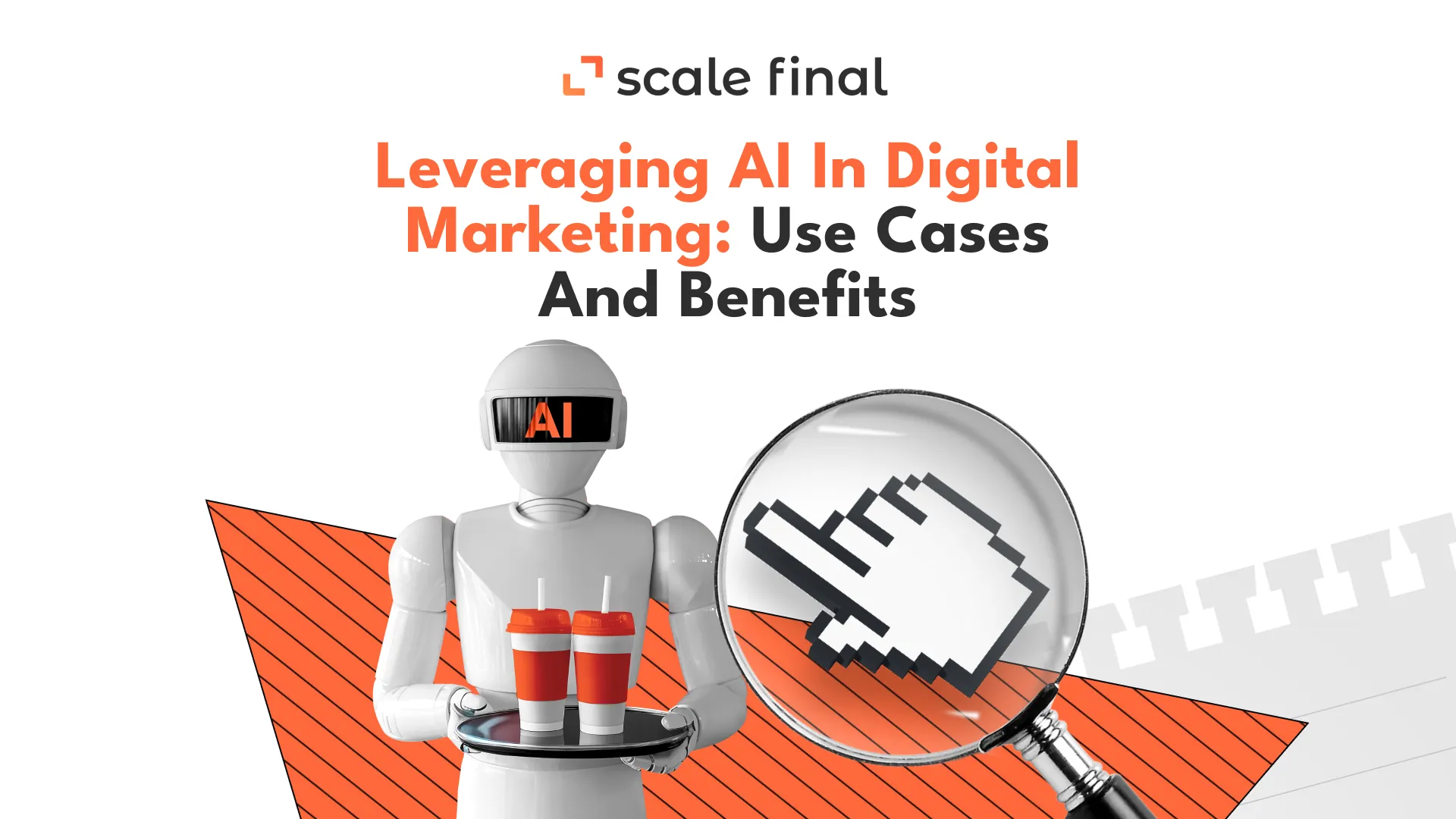
Leveraging AI in Digital Marketing: Use Cases and Benefits
August 5, 2024Company
Most of us, businesses as a whole and mere workers of the industry, are still figuring out how to most effectively use Ai, this evolving technology. And it’s not like it’s just a big word. While AI might be as not as hyped as it was back in 2023, and whilst tools of all kinds have been used literally across the board, in 2024 it is still perceived as too hyped, – read, the technology is not there yet, so what’s the fuzz?Yet, a more clear sentiment is emerging: AI is relatively immature, but these current limitations work in favor, and they offer a great potential, and not just for the developers. And for the mere workers, even with this current state of AI, there’re already huge benefits and great use cases, that we’re about to share in this article.One more quick word before jumping in: this article will suit only those seeking how to optimize your daily and work life, and it’s certainly not for the benefit of those who just want it to be shoehorned into your work or products just for the sake of it, not adding any value what so ever.If you’d be interested, we will write an exposure article of these fishy AI use cases, just let us know.Now we begin. Has AI Fully Arrived In The Industry? At this point, we pick up on some findings that we have already published in our weekly Marketing Digest – Dripped Digest – on LinkedIn: It turns out that despite the fact that the media liked to exaggerate the “transformative” impact of AI on the world of work, the pace of adoption has slowed compared to 2023. In Retool’s survey on the current state of AI, while many respondents said that their companies are either “running” or “flying” when it comes to AI adoption, overall the number of those who consider themselves leaders has dropped from 13.4% in 2023 to 9.8% in 2024. Furthermore, the progress reported by respondents is largely not transformative — or at least not yet: the impact of these use cases is rated an average of 6.7 out of 10. And here are some more juicy facts. Even though AI is so great, not all workers are allowed to use AI at work. A higher percentage of 64.2% in 2024 compared to 54% are allowed to use AI freely, but still more than a quarter (27.3%) of employees use AI secretly. And why? So, this article has just taken a turn. The translation of the data above and the whole sentiment of this article: If your company doesn’t know where it stands on AI yet, you could be one of the workers using AI in secret, or join them. Or you could use it as an opportunity to talk to managers about whether you and your team should be allowed to use AI for whatever reason. It’s a good thing we’ve already prepared a list of the big WHYs: why is it useful and why is it safe. AI Use Cases Am I the only one who, when confronted with something completely new, is the first to check whether there is an AI tool that is created to help with exactly that? But let’s start with the most common use cases of AI and then go into more detail. Chatbots for support, which are often used as an example of chatbot usage, are only the third most popular internal live use case for respondents, with writing code or queries coming in first at 42.1%, followed by knowledge base questions at 36.4%. The use cases for content creation are more mixed. While most use cases were within a few percentage points compared to our last check at the end of 2023, there was a divergence of around 5 percentage points in some areas – trends we will keep an eye on: Writing code or queries dropped 5.4 points from 47.5 to 42.1%, as did texting from 32.9% to 28% Support chatbots increased by 5 points from 28.9 to 33.9% Automation of workflows increased by almost 5 percentage points from 12.9 to 17.8% Quick note: Although Retool calls AI notebreakers a harmless use case, we at Scale Final use them daily, and although it’s very simple, it increases productivity and keeps us all on the same page. On a side note, there’s no room for those who weren’t paying attention or weren’t even present during the conversation. And now for more application examples from our team: Sviatoslav P., CMO: Mariia L., graphic designer: Semyon I., Youtube head: Igor V., a full-stack developer, and I, Yana P., a content writer, speak from the heart: ChatGPT is the king of kings. It’s great when you’re investigating or learning about a new tool or service. It speeds up the process immensely. It’s also great when you need a simple explanation with pros and cons that gives you a basic understanding before you dive in. One more present: 41 tools for everything in digital marketing. Just follow the link and enjoy your streamlined processes. AI Benefits: Improving Individual and Organizational Performance While the use of AI technology is still in its infancy, it is undeniably changing the way we work— – transforming tasks from the mundane to the complex. Despite the gradual adoption and mixed feelings about the current possibilities, the benefits of AI on an individual and organizational level are significant and deserve attention. 1. Increased efficiency and productivity: AI tools have proven successful in automating repetitive tasks, allowing employees to focus on more strategic and creative tasks. This not only increases productivity, but also job satisfaction by reducing the burnout associated with tedious tasks. 2. Improved decision making: AI’s ability to analyze large amounts of data quickly and accurately provides employees and managers with insights that were previously unattainable. This data-driven approach supports better business decisions and promotes a more analytical and informed company culture. 3. Increased creativity and innovation: By taking over routine analysis and
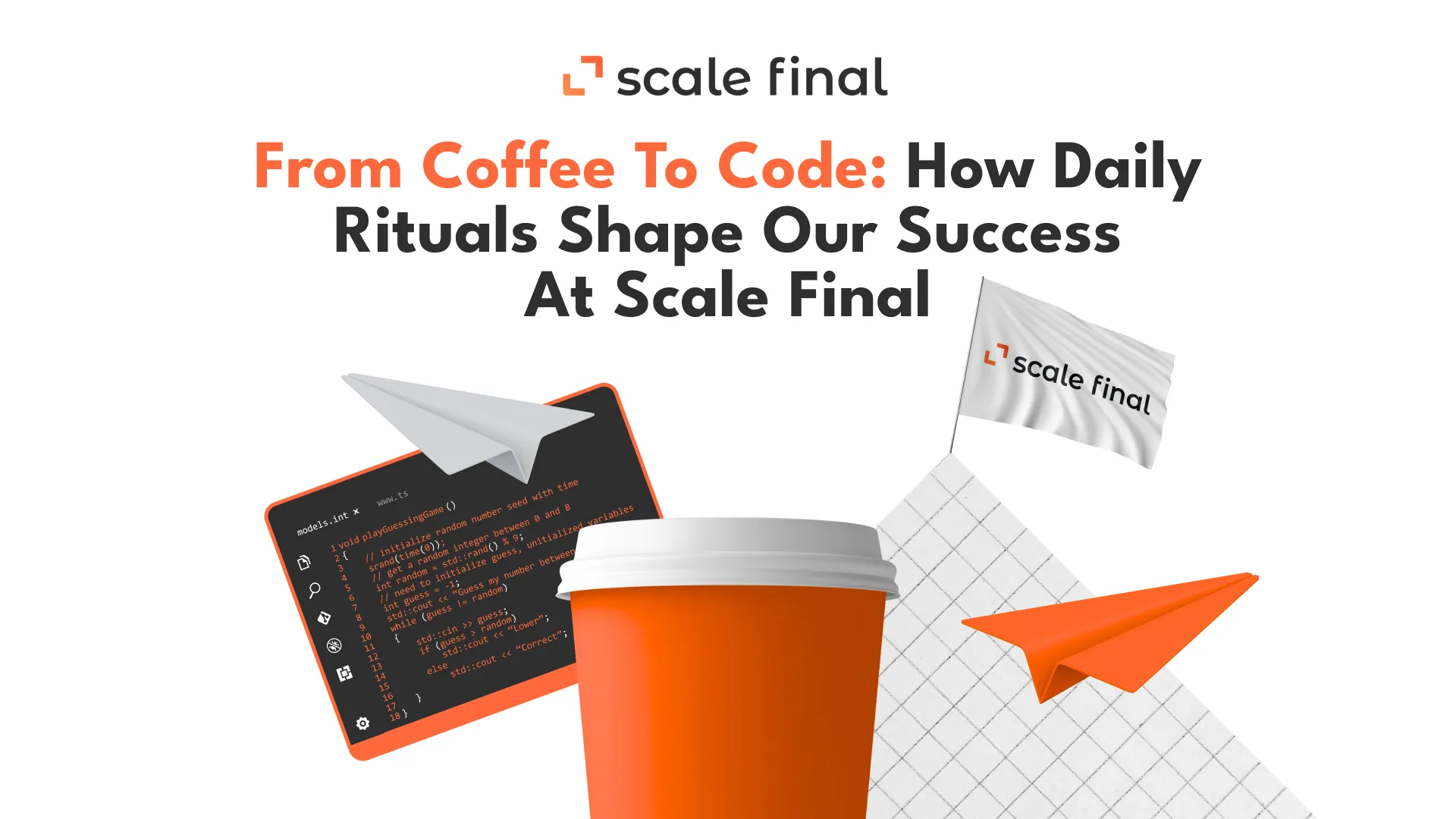
From Coffee to Code: How Daily Rituals Shape Our Success at Scale Final
June 14, 2024Company
The motion of work-life balance is not popular just because we all have that neurotic part of us that, if not reminded, can bury us in work to get more done. It’s not because we do it for our own good, the good of our physical and mental health. It’s a popular motion because the companies that think about the health of their employees are more successful in the long run. Thus, for a company to find a balance with each individual employee between their professional duties and their personal time. At Scale Final, we too believe in the power of finding the right balance to create a supportive and successful work environment. We also believe that there is no limit to improvement, and we are constantly on a journey to get to know our employees better. When we know them better, we also know how to create better conditions for them so that our results are better and we are more resilient as a team. We recently hired a Happiness Manager to make sure everyone gets what they need, but also to collect and analyze data to continuously assess the impact of our joint offering. Anton has conducted a study on the interests of our employees so that we can launch more community-building activities tailored to their interests.In this text, we give you a general overview of our interests, how some of them become rituals and how this affects our business success. I have chosen to divide these rituals into a morning-day-evening framework and then add how this influences the entity called “Scale Final”. Morning rituals: Activating the Mind and Body How we start our day sets the tone for the hours that follow. For some of us, such as myself, a morning workout is key to kick-starting the brain, as science proves the benefits of exercise for cognitive clarity and energy. Others may find peace and contentment in meditation or yoga, which also aligns with studies highlighting their stress-reducing and concentration-boosting effects. Daytime rituals: With or without music As soon as the working day begins, our routines are different. Silence is worth its weight in gold for those who require deep concentration, research supports the idea that certain types of music or ambient noise can stimulate faster and more innovative thinking. Whether it’s the quiet of a noise-free room or the motivational boost of a playlist, the key to our productivity lies in finding what best enhances our concentration. Vladyslav’s playlist of soundtracks for competitive games could be considered unconventional, but it’s backed by research that suggests certain types of music can increase alertness and improve the ability to complete tasks faster. These different preferences reflect a universal truth: there is no one-size-fits-all strategy, even for productivity. Embracing our differences is key to fostering an inclusive and supportive workplace. Good thing we don’t have to conform, because Scale Final manages remote teams across Europe (link). Evening rituals: unwinding Relaxing after a busy day is just as important as the work itself. Activities such as playing, sports or spending time with pets not only help us to relax, but also play an important role in mental health. Studies show that leisure activities can significantly reduce stress and improve overall emotional well-being, allowing us to recover for the next day. There has also been the idea of taking one lazy day a week to switch off (link). So take the opportunity to take a deep breath in this fast-paced world. Our common thread: A commitment to culture and community What unites us at Scale Final is not just our individual routines, but our shared commitment to a work culture that embraces diversity in work habits. By recognizing and supporting everyone’s best practices for success, we create an inclusive, innovative and productive environment.
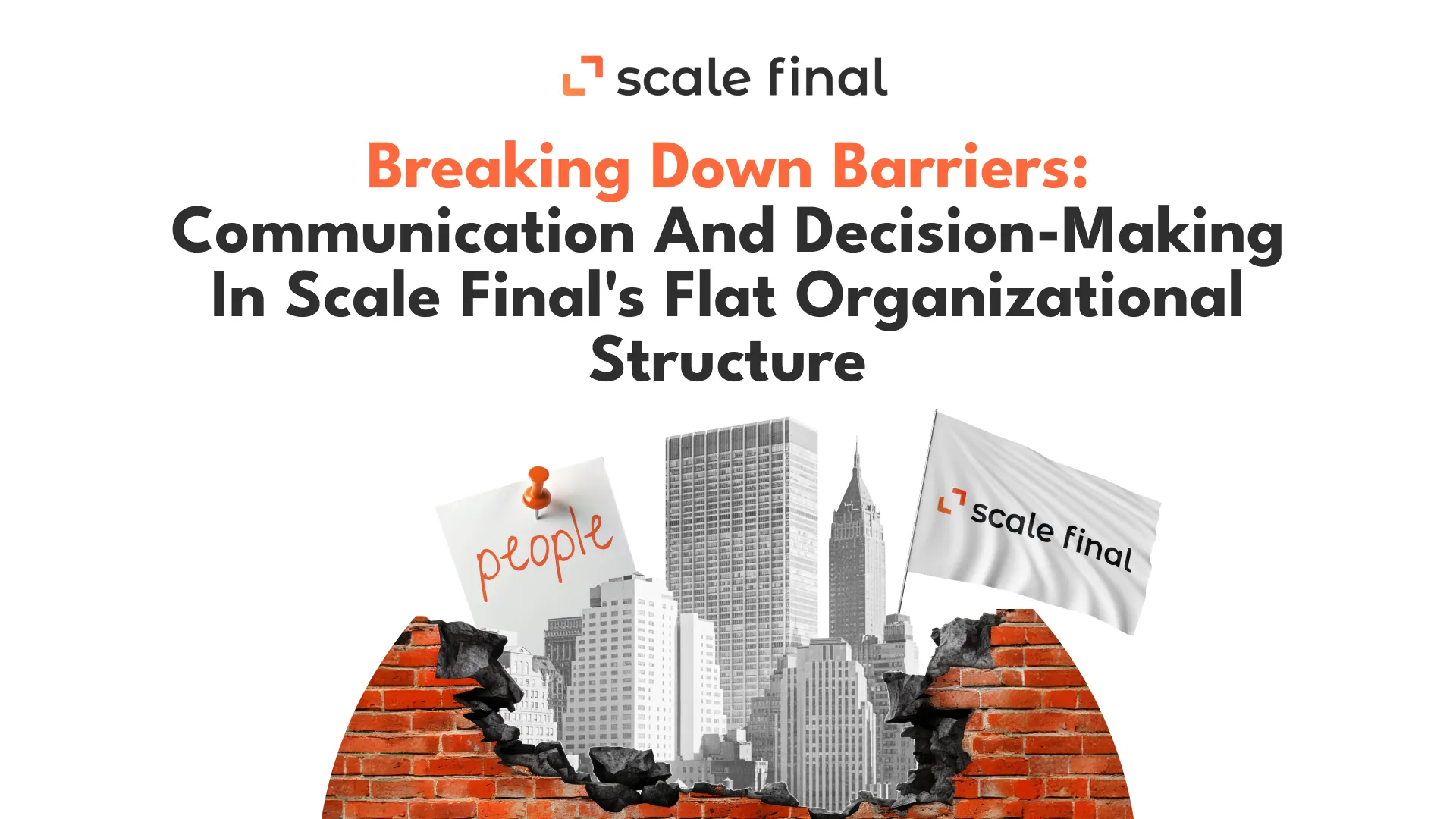
Breaking Down Barriers: Communication and Decision-Making in Scale Final’s Flat Organizational Structure
June 3, 2024
Let’s face it: traditional hierarchical structures are good in traditional circumstances with traditional people with their highly predictable future within traditional belief systems. But the way we live today, no matter where on the globe, is anything but traditional. We work remotely, in projects and the rules of our work are changing fast. When you then factor in the pace of technological progress, traditional hierarchies can only slow down innovation because they slow down decision-making processes, for example. At Scale Final, we have opted for a flat organizational structure and a dynamic and inclusive workplace. This means that every individual is involved in the processes and develops ideas without the constraints of traditional hierarchies. Embracing Inclusivity The best ideas can come from anywhere and anyone. You can only organize your organization so that everyone is allowed to be creative and you are willing to hear every voice, from interns to executives. This breaks down barriers and creates a free flow of ideas and perspectives that fosters innovation and creativity. By giving everyone a seat at the table, we harness the collective intelligence of our diverse workforce. (The idea that interns are subordinate to managers is a bit outdated, especially in this creativity. People can be creative at any stage of their career, and it’s certainly not defined by their current position. In addition, we are fortunate that all our employees are simply brilliant, with some simply being longer expert than others). Open Communication Channels Some people have nervous tics when they receive notifications from Microsoft Teams or Slack. You can’t really control the fact that some find their job a form of torture. What you can do is create an atmosphere that is as transparent and understanding as possible and encourage your employees to communicate so that your team becomes a community. We have created open communication channels (not just work-related, of course) where employees can freely share their thoughts, concerns and ideas without fear of judgment or bureaucratic hurdles. Incidentally, we also have a channel with cats and dogs, with one of our developers reminds us all to celebrate “It’s Wednesday, dudes” day. It all gets the conversation going, ensures transparency, mutual understanding and brings a bit of fun and levity to the game. Collaborative Decision-Making The creative process does not end with making decisions. Although, of course, in a traditional hierarchical structure, decision making is often in the hands of a few managers. At Scale Final, we involve employees at all levels in the decision-making process. Everyone has a sense of ownership and responsibility. When employees feel that their input is important, they are more engaged and motivated to work towards common goals. And in a way, it just feels more natural when you think about it. Of course, this can only happen if you hire professionals. Empowerment and Autonomy One of the main advantages of a flat organizational structure is the personal responsibility it gives employees. Without rigid hierarchical boundaries, team members are encouraged to take initiative, experiment with new ideas and lead projects. This autonomy fosters a culture of trust and respect where employees feel valued and are more willing to take calculated risks that can lead to breakthrough innovations. Realizing Ideas Together The path from idea to implementation is a collective effort. Teams from different departments work together seamlessly, using their different skills and expertise to bring ideas to life. This collaborative spirit is also evident in our project management practices, where teams work in an agile and flexible way, adapting quickly to changes and challenges. By working together without hierarchical constraints, we achieve more and celebrate our successes as one. Continuous Improvement Our flat organizational structure is not just about breaking down barriers, but also about continuous improvement. We regularly gather feedback from our employees to improve our processes and practices. By constantly evolving, we maintain our competitive advantage and ensure sustainable growth. Conclusion At Scale Final, we pride ourselves on our flat organizational structure that fosters inclusion, open communication and collaborative decision-making. By giving every employee the opportunity to actively contribute to our processes and develop ideas, we create a dynamic and innovative workplace. We are confident that our collective efforts will lead to great success as we continue to break down barriers.
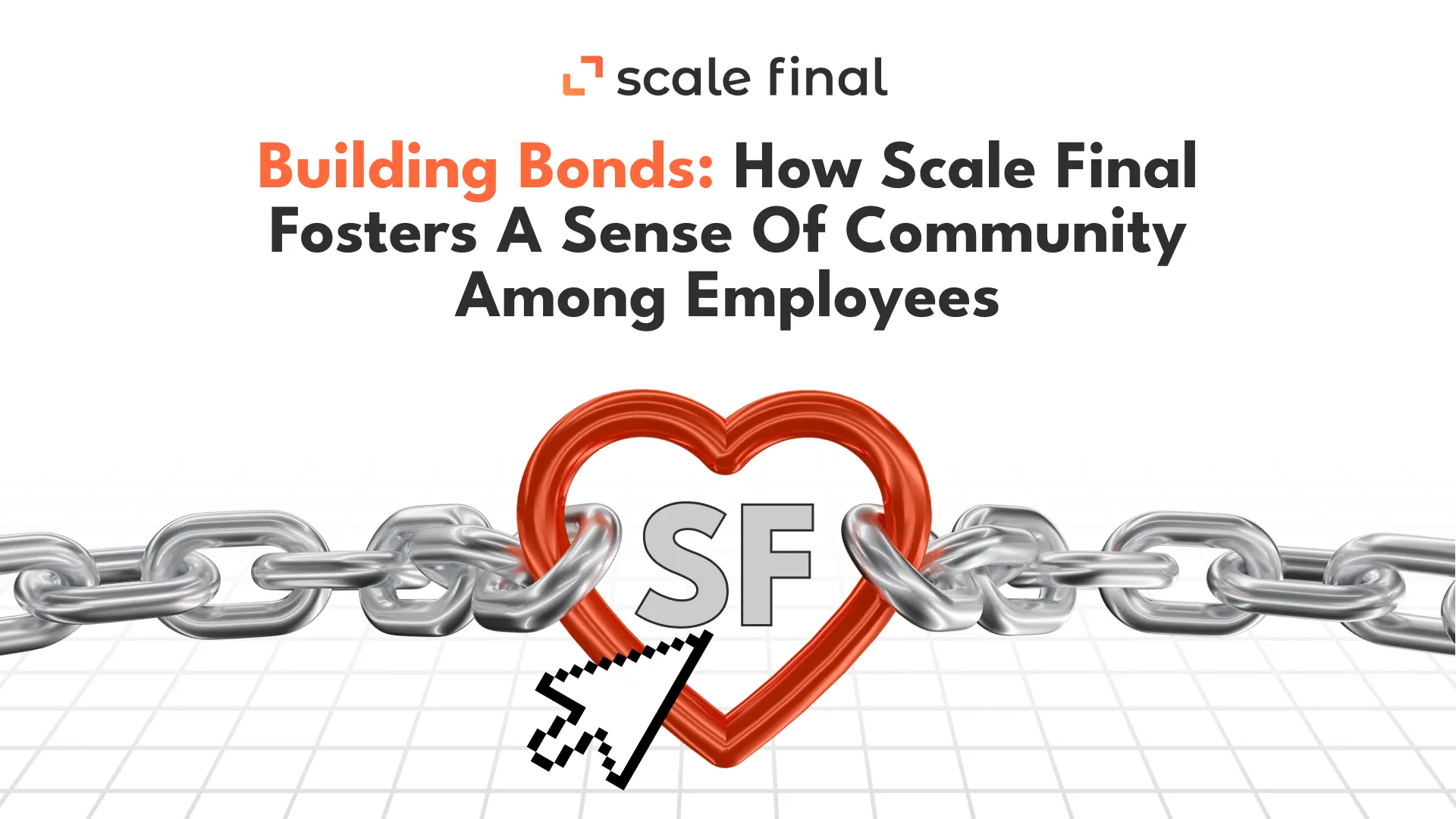
Building Bonds: How Scale Final Fosters a Sense of Community Among Employees
April 25, 2024Company
People can only band together in groups or form a community if the atmosphere in the workplace doesn’t feel too bureaucratic, rigit and, well, off. (Or people can band together against oppressive bosses, but that’s a story for another blog post.) Before a company introduces mandatory parties, off-work activities, team buildings, etc., it needs to think about itself at a C-level, figure out the goals and aspirations, the values behind the company, and then formulate a clear and transparent company culture so that its employees can live those values. Good thing we don’t have to go into detail about how a company does this and why, because I’ve written a piece about that already (find here). Once you have formulated these values, which are the backbone of any organization that strives for sustainable growth and long-term existence, and your team implements them, you can foster the sense of community in two steps: Today we will talk about how to approach this task of building connections, why certain activities are better than others and why you need to foster a sense of community among employees. People-first approach People-first approach means that the company should recognize each employee with their unique contributions and respect their individual needs and aspirations. This can manifest itself in different ways. For example, flexible work schedules, the ability to be remote and regular face-to-face meetings can help managers and employees build mutual trust and align on personal and career goals. You are not their dictator. Your employees, regardless of rank, are in some ways your mentors and advisors, as long as you hired the professiolanls in their respective fields. And, of course, they are people too, not functions or mere task performers. This empowerment boosts morale and fosters a sense of belonging and purpose, which is critical to building a community. Introduce community-building activities As I mentioned earlier, you also need to encourage community building by introducing activities outside of work so that people have time to get to know each other. Choosing the right activities is crucial: they should reflect the values and culture of the organisation while catering to the diverse interests of employees. Here’s how you should go about choosing these activities: Evaluate the impact Finally, it is important to continuously evaluate the impact of these community-building activities. Regular surveys, feedback forms and discussions in town hall meetings can provide invaluable insights. Metrics such as employee engagement, job satisfaction and participation in activities can provide quantitative data, while employee testimonials and anecdotal evidence can provide qualitative insights. By combining a thoughtful people-first approach with strategically selected activities, Scale Final creates a thriving community.And we not only operate efficiency. We are also a resilient and engaged collective that is equipped to meet the challenges of a dynamic business environment.
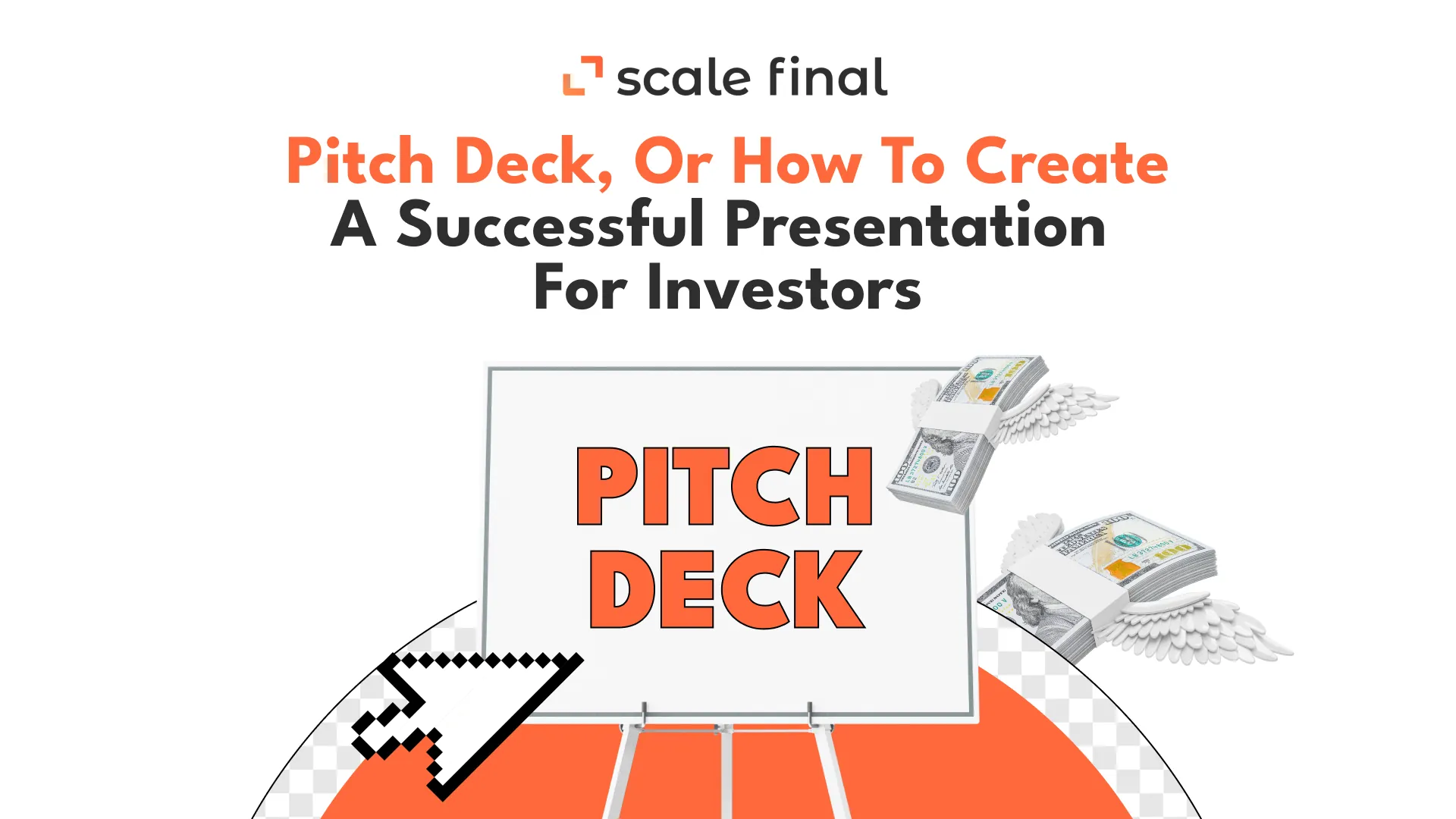
Pitch Deck, or How To Create a Successful Presentation For Investors
March 21, 2024Company
You have a brilliant idea for a product or have already developed one. You need to market it, so you need to scale up. Where will the money come from? Investments. To achieve the goal, your product shouldn’t be amazing and promising only on paper, but a great opportunity for the money to flow in. You need proof, be it a talented team, a solid business plan, data, or something else, to ensure investors see it as an opportunity. It’s nothing more than a business where investors need to understand that their contribution is not free but will bring profit and revenue. A great communication tool has been invented for this. It is designed to help entrepreneurs and investors meet and make this opportunity a reality. It’s a pitch deck, a concise presentation about your product that bridges the gap between the tangible and the intangible. This pitch deck is pretty mundane, and as with all basic things, you must master it. There are countless examples of successful pitches, some of which we’ll share with you in this text. We are discussing this because we just founded a TechScale Hub, an investment hub and an accelerator. You’re about to find out what we expect from our applicants. They expect us to show them the way and how to make it. What is a Pitch Deck? A pitch deck is a business presentation typically of 10 to 20 slides that gives an overview of your company, business approach, notable achievements, and vision for the future. The number of slides is not strict, and even the content of it depends on your purposes, from presenting your company online to showcasing your startup at events like demo days. Yet, there are some similarities in investors’ expectations for a successful pitch deck presentation, which are highlighted in the text below.To overview them, a pitch deck must be: 10 Musts For a Pitch Deck Presentation As mentioned above, there are some variations depending on the goals and preferences of each investor. However, here are the most important elements you can use as a structure for a pitch deck: Individual With a Potential Product vs. Startup With Existing Product A pitch deck is used to effectively communicate your business idea to potential investors. However, the focus and presentation may differ slightly depending on the stage and target group. For individuals or early-stage startups, the focus is often on the vision, the problem to be solved and the potential market opportunities. You need to create a compelling picture of what could be, with a strong focus on the concept and the founder’s ability to execute this vision. This includes: The narrative is key at this point, as you may not have meaningful metrics or financials to back up your proposal. In contrast, established startups will be expected to provide more concrete evidence of their business’s viability, such as: This may include presenting customer feedback, sales figures, partnerships and competitive advantages. The team’s experience and past successes also play an important role in building credibility with investors. Established start-ups should explain how additional funding can boost growth, expand operations or open up new markets. Regardless of the stage you are at, you should avoid common mistakes such as: Always aim for simpe, clear and a compelling narrative that engages on both an intellectual and emotional level. How to create a successful pitch deck for investors The story should be logical and intuitive, so that anyone will follow and understand your business’s journey. Like any story, your pitch should have a beginning, middle and end, with each slide builds upon the last to create a clear narrative about your startup. Avoid industry jargon and complicated language. Your presentation should be understandable even to someone who has no prior knowledge of your field, and present the value proposition clearly and concisely. Focus on the human aspect of the problem you are solving. It’s important that you show a deep understanding of your users’ problems and illustrate how your solution makes a difference. Use compelling visuals to complement and enhance your narrative. People process images faster and remember them longer than text. This means that images can significantly improve the impact of your presentation. Highlight data on paying customers or growth metrics lends credibility to your business. This tangible proof of the suitability of your market fit, and the viability of your business model is often what investors are most interested in. Provide clear evidence of your business’s growth, revenue generation, customer satisfaction and engagement. These factors are key to convincing investors of the scalability and potential return on their investment. Investors do take risks, but they are ultimately looking for ventures that promise a high return. If you can demonstrate your start-up’s potential for exponential growth and a strong market position, it can help achieve their investment goals. Successful pitch deck examples

United in diversity: How Scale Final builds and manages teams across Europe
March 18, 2024Company
Scale Final has been around for over four years, and we are now over 200 people. In 2021, we had an office in Kyiv. Since then, we have had two new spaces—one in Cyprus, Limassol, and the other we recently opened in Warsaw, Poland. At the same time, many of our employees work remotely—from Kyiv to London and Lisbon. So, how can we communicate and keep the job going in these long-distance relationships? Some of the following thoughts are better explained in previous articles (this and this). Firstly – and most importantly – a clear corporate culture. Let’s divide the corporate culture into two parts. First, the main task of management is to formalize a certain pool of company values, goals, and guidelines so that the whole team is on the same page. I hope that doesn’t sound too obvious. In practice, many companies do not formalize their values. More often, they remain at the level of onboarding (we will talk about this and the importance of this process next time) and clearly formulate tasks about the necessary personal KPIs for the employee and—in general—for the company. Ultimately, our job and workplace, both physically and figuratively, are not about these KPIs. It’s about how you feel about yourself, the conditions under which you work, your relationship with your colleagues, etc. This brings us to the second part of corporate culture – namely, how a certain set of rules is implemented and lived by your employees. If the corporate culture is only on paper and your team works differently, you shouldn’t be too quick to fire your employees if they don’t conform to the ‘spirit of the company’. Most likely, the problems lie in what and how you have formulated it. Company culture is about how things actually work in your company. It’s meaningless if your employees do not share it. And only then can it be described as transparent and understandable if the gap between expectations and reality—between the guidelines and values and the everyday lives of your employees—is minimal. The difference is there. It’s not ideal. There must be something to strive for. How can I test your corporate culture for transparency? There is no universal screening tool. You will not survey your employees. However, anonymous surveys are a viable option. But there is a cooler tool. Your company culture is truly successful when your employees not only share your ‘paper values”, but also formulate and add their values. The test is simple. Ask yourself: What else is vital for maintaining long-distance working relationships? Online parties? Frequent Zoom calls? Not enough. While these elements increase engagement and fun, they’re not enough on their own. At the heart of Scale Final’s strategy is trust. It’s about making each team member feel secure in their role and in their interactions with others. This is ensured by fostering horizontal relationships where open communication and mutual respect are the norm, regardless of position or location. Such an approach fosters a sense of belonging and engagement so that geographical distance does not matter. Even if we are talking about work, this does not mean the need for solid and reliable human connections disappears. In other words, these are not just exchange relationships, but communal in a sense. In this context, the role of the HR department is crucial. The company hires HR professionals who do well with administrative tasks and can nurture these relationships and make each team member feel valued and understood. Conclusion Scale Final’s success in managing teams across Europe is a testament to the power of trust, horizontal relationships and strategic HR practices in creating a cohesive and vibrant work culture united in its diversity.
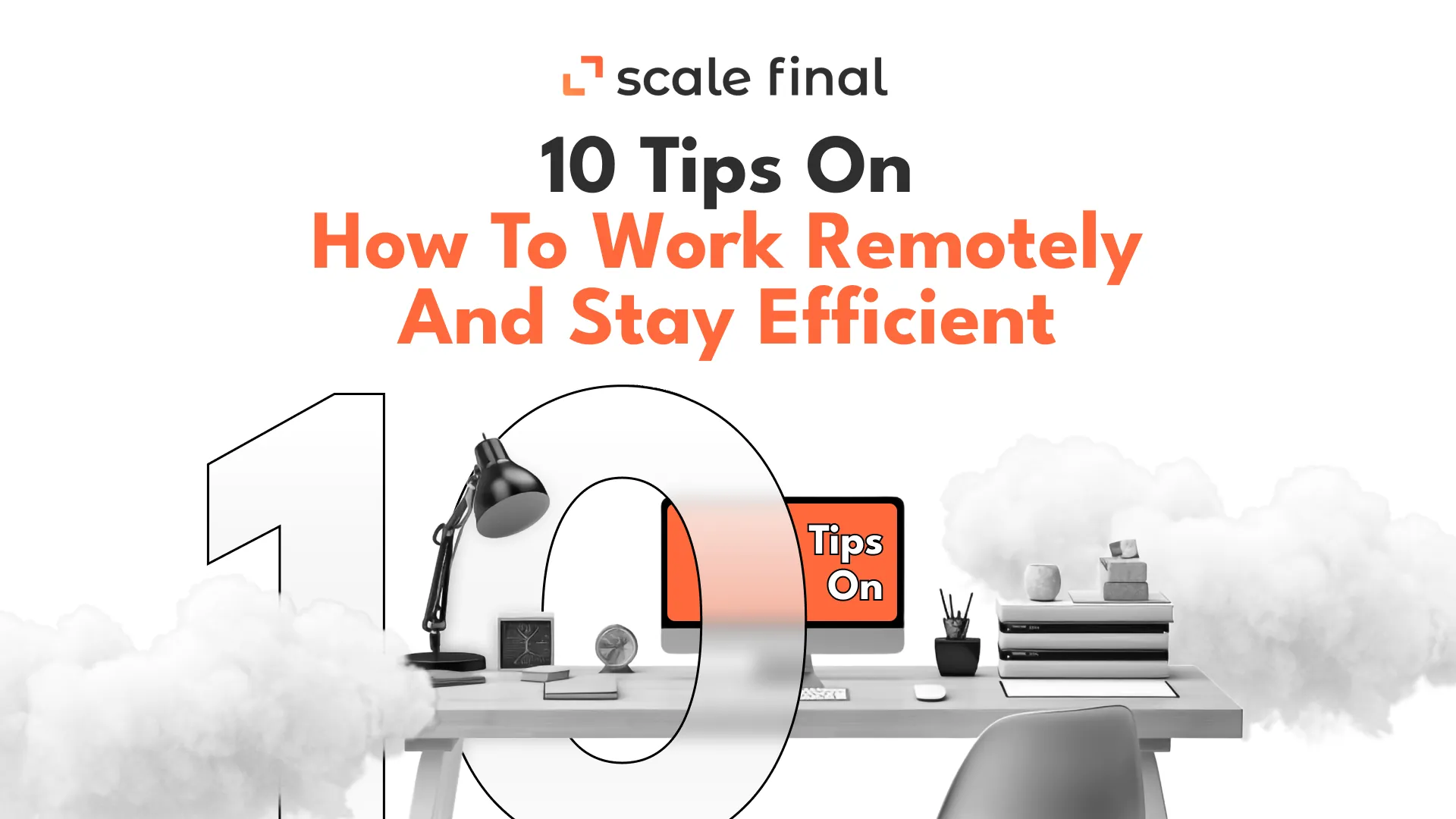
10 Tips on How to Work Remotely and Stay Efficient
February 22, 2024Company
This blog is not about pros and cons of remote work. Focus is laser: how to stay efficient when we work remotely. It turns out it’s not so easy to assess your performance when you’re by yourself. We all have our reasons to worry: On the other side of the remote office, everyone is alone with their worries and sometimes their problems. But perhaps the problem of personal effectiveness and professionalism is the main one. So how do we unlock our potential? With this approach, the team works flexibly, knows which way to go, and is not prone to burnout. All employees are doing what they enjoy, not just converting time into money. But that’s just the only one side of a thing. Corporate one. I decided to talk to each team member and we came up with these ten principles to help us stay effective when working remotely. 1. Exercise When – in the morning, during your lunch break, after work – that’s up to you. But exercise is necessary. It is necessary for your physical and mental health. On the one hand, of course, all office workers suffer from a lack of exercise, but at least they go to work. For remote workers, exercise is minimal. Where to start? According to ASCM research, just five minutes of light physical activity every half hour is enough to improve health indicators. This means that you should at least get into the habit of changing your body position more often – for example, sitting, standing and, heaven forbid, lying down. On a yoga mat. We ignore the bed!!! 2. Set clear schedule In the office space, there are always desk hours and a fixed place to work. When we leave work, we ideally put it outside the door. When working remotely, this causes even greater problems. Spread the work out separately and don’t take on tasks outside the set times. You can of course discuss this with your boss, but it is your right to close the work chats after the end of the working day. 3. Clear corporate culture Even if an employee is not physically present, it’s important that they feel a sense of belonging and know that everyone on the team understands the value of their contribution. We have written extensively about our culture here. I would like to add that it is very cool when the company culture is passed on naturally from employee to employee and is not chiseled in marble and imposed from above. Because in this case, it can also be felt by a person who originally came to work remotely and has never been to the office. 4. Frequent sincups Our team lives in different time zones. That’s why we practice a flexible start to the day with a standard working day of eight hours. We synchronize by Kiev time. We meet weekly at 2 p.m. for a sincup – apart from the fact that this sets the work rhythm, it makes us even more united, learn from each other and really understand that we are a team working for a cause. In our case, more than once our content writer got inspiration from such calls, and we have created cool content for social networks. 5. Real-life communication Whether you’re an extrovert or introvert, the need for live communication exists in all of us. Social meetings with colleagues, which often take place without cameras, cannot satisfy this need. That’s why you shouldn’t forget live communication with your friends (likes on stories don’t count!!). Apart from the fact that the quality of this communication has a direct impact on your mental health, it’s a great way to diversify your free time: A change of scenery allows you to reset your brain and think more creatively – don’t read “How to spend time with your friends while working remotely full-time”. 6. One lazy day per week Finally, it’s official. Having one lazy day per week can help reduce stress, and high blood pressure and improve mental health!Don’t just take our word for it. If you don’t pick a day to relax, you body will pick it for you…Relaxing really is a precursor to being more productive. We after think productivity means to work. It doesn’t. Productivity means making intentional choices towards a goal. And sometimes this choice could be to have a lazy day and replenish…You can optimize your sleep, your food, your gut, your energy – but unless you have some real time off, to sit around and do nothing and reflect and appreciate where you’re at, you’ll never repair or operate properly. Tim Grey Health Optimizing Biohacker, Psychology Specialist. 7. Have fun The dark horse and the underdog of solid working relationships. It’s hard to separate a welcoming home and boring work hours when you’re working completely remotely, but company traditions and informal gatherings (read: The Office) can also be a good way out. Who said work has to be boring anyway? Stay creative and celebrate creatively. You can’t force anyone to participate, but you could initiate or show your coworkers a good time. 8. Self-discipline Even if your manager floods your inbox with emails about deadlines, no one will breathe behind your back, and notifications can be put on mute. It all boils down to self-discipline, once again. It’s not up to you alone, but you must understand which tasks to do and in what order, and you even have a head start, because that’s up to you. Everyone has their own routines, their own habits, their own self-organization know-how: control the flow of information by turning off non-working messengers get important things done first remove completed tasks from your daily planner take a 5-minute break every 1.5-2 hours to reset your mind. At Scale Final, we have our own approach. We always break large tasks into smaller tasks – sprints. In a sprint, we set specific tasks. That makes it easier to finish the whole. We work a lot on
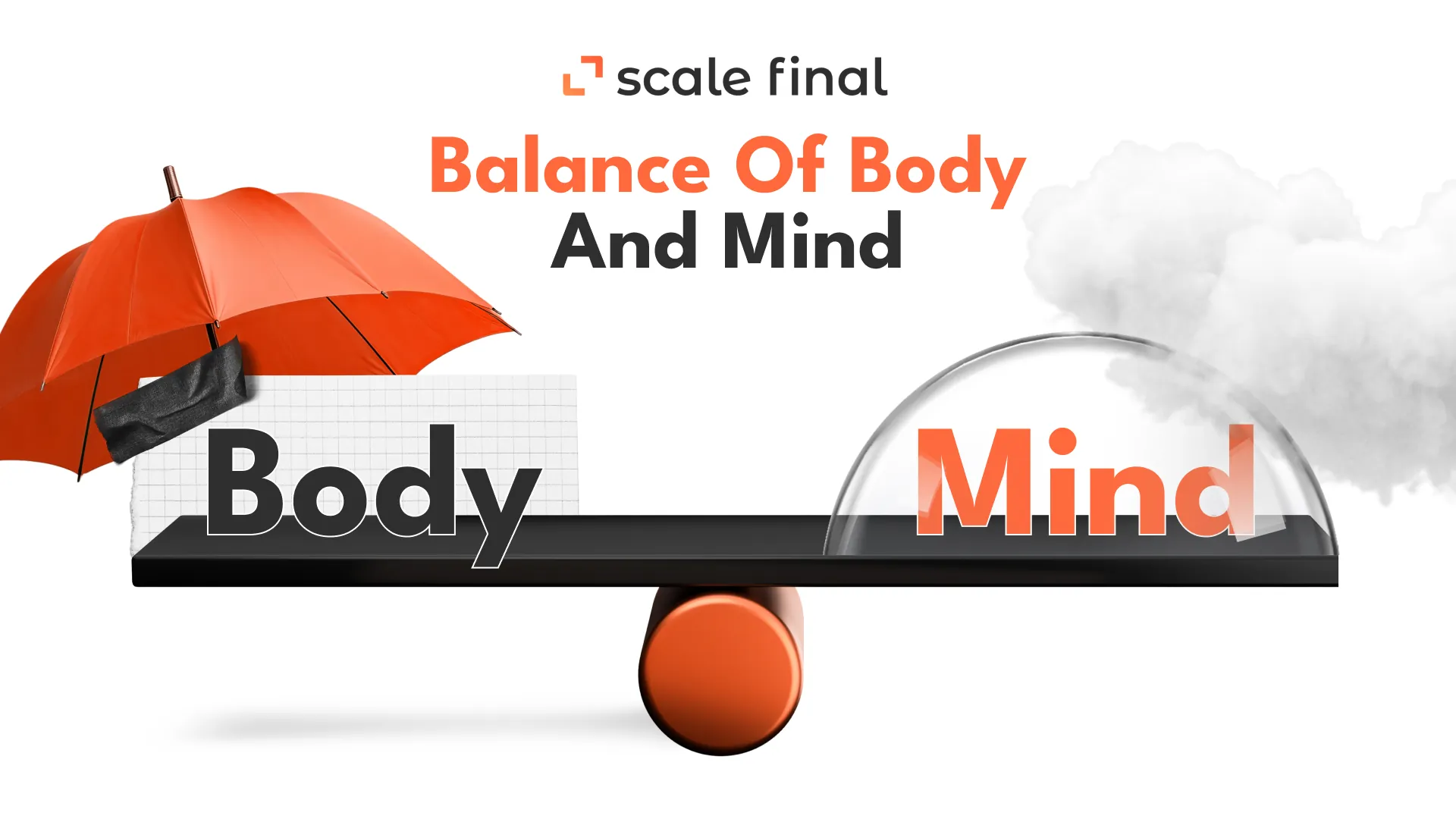
Balance of Body and Mind: Corporate and Personal Perspectives
January 30, 2024Company
I don’t want to brag, but I exercise every morning. It keeps me productive and focused, at least until lunch. But then comes the coffee. These stimulants are a must for everyone, but especially for us with our dynamic working environment at Scale Final. This article is not about science and science-based tools for daily life and work, but about giving our team members real-life examples of how we maintain that balance – of Body and Mind.Before we begin: Did you know that your manager has a greater impact on your mental health than therapists and doctors? 69% of 3400 people from 10 countries surveyed by The Workforce Institute at UKG said so. If you’re a manager, you should know how to mitigate stress and create the healthiest possible atmosphere for your team. As an employee, you should choose who you work for and who you work with. Or you can start by buying cacti and putting them on desks like we did recently. Balance of body and mind: Corporate guidelines A healthy mind in a healthy body. Our team has not only heard this saying many times, but has also seen it in practice. For example, we have a partial gym membership and health insurance. Since we spend so much time working, we have to move our bodies somehow. That’s where the presise office space organization comes in handy. Things like table tennis and table soccer are another must for healthy teams, both literally and figuratively. In our old office in Kiev, we also had a ping pong table near the buffet wall. I can’t tell you how popular that was.Every time several people met for coffee in the kitchen, it ended with a game of table tennis. We even had little competitions. A few words about the office environment Think about it again: We spend ⅓ of our time at work. In our new office in Limassol, we don’t have a table ping pong table yet, but we do have cacti. One plant per desk to reduce stress and increase productivity, and lots of plants throughout the office. Something to take care of and grow together with. In the kitchen, we’ve tried to keep treats and fruit/vegetables/organic snacks in a 50/50 ratio. We still have cards up our sleeves: We’re big fans of action sports. Paintball. We even did it at a company event. We went quad biking and jet skiing, played bumper ball, billiards and bowling and took part in active quests. But above all, of course, we’re fans of board games and Sony PlayStation And we were lucky. A developer and a former tester, a powerlifting coach and a wrestling trainer. Both gave us tips on nutrition and training equipment and even arranged private training sessions.The developer even created a nutrition plan for David Atias, one of our co-founders. Body-Mind Balance: Personal Perspectives Top Advice: Calendar is your best friend To balance body and mind, I’ve to use my calendar. I set aside time for different things – for example, barre workouts (try it!) and even eye exercises to relax from screen time. I also make time to learn new things to keep my brain active. It really comes down to finding what works for you. Remember that your calendar is your best friend for keeping track! Anastasiia, Product Manager Top Advice: Treat yourself regularly I’m a creative person and I need to be constantly inspired to be productive, but at the same time keep a balance so I don’t burn out. It’s tricky, but I’ve found my pattern. Sleep is an important part of success: when my body is rested, it performs better. It’s like before an exam – there’s a category of people who study everything at night, and there are those who sleep well and pass everything with a fresh head. I belong to the second category. Physical exercise – I love running and it’s one of the best ways for me to clear my head and improve concentration) Jogging after work is perfect. Also an invisible rule – before I go to bed I always take time for myself, read a book, watch a movie/series and on Fridays I always order junk food to celebrate the working week. Mariia, Graphic Designer Top Advice: Meditate and find something to be thankful for My girlfriend and I always start our morning with 3 things we’re grateful for. We thank the universe for 3 precious moments, lessons or people we love. We have a coffee and tea limit. We don’t drink more than one specialty coffee and no tea before bed. We go to yoga every day. Flow is our favorite because it allows us to feel our bodies, ground ourselves and free ourselves from stress and stuckness. We do meditation in the evening. A variation of a good meditation, the candle contemplation, Trataka (you can read about it on the internet). In the first hour in the morning and in the hour before going to bed, we also do without gadgets, which is important. We write down all the things that accumulate during the day in a notebook so that we don’t keep them in our heads. It’s mandatory to go to the water once a week. This can be a river, the sea or the ocean. It’s mandatory to meet up with friends at least once a week, at least for a cake after work) social contacts are very important. Sviat, CMO at Scale Final
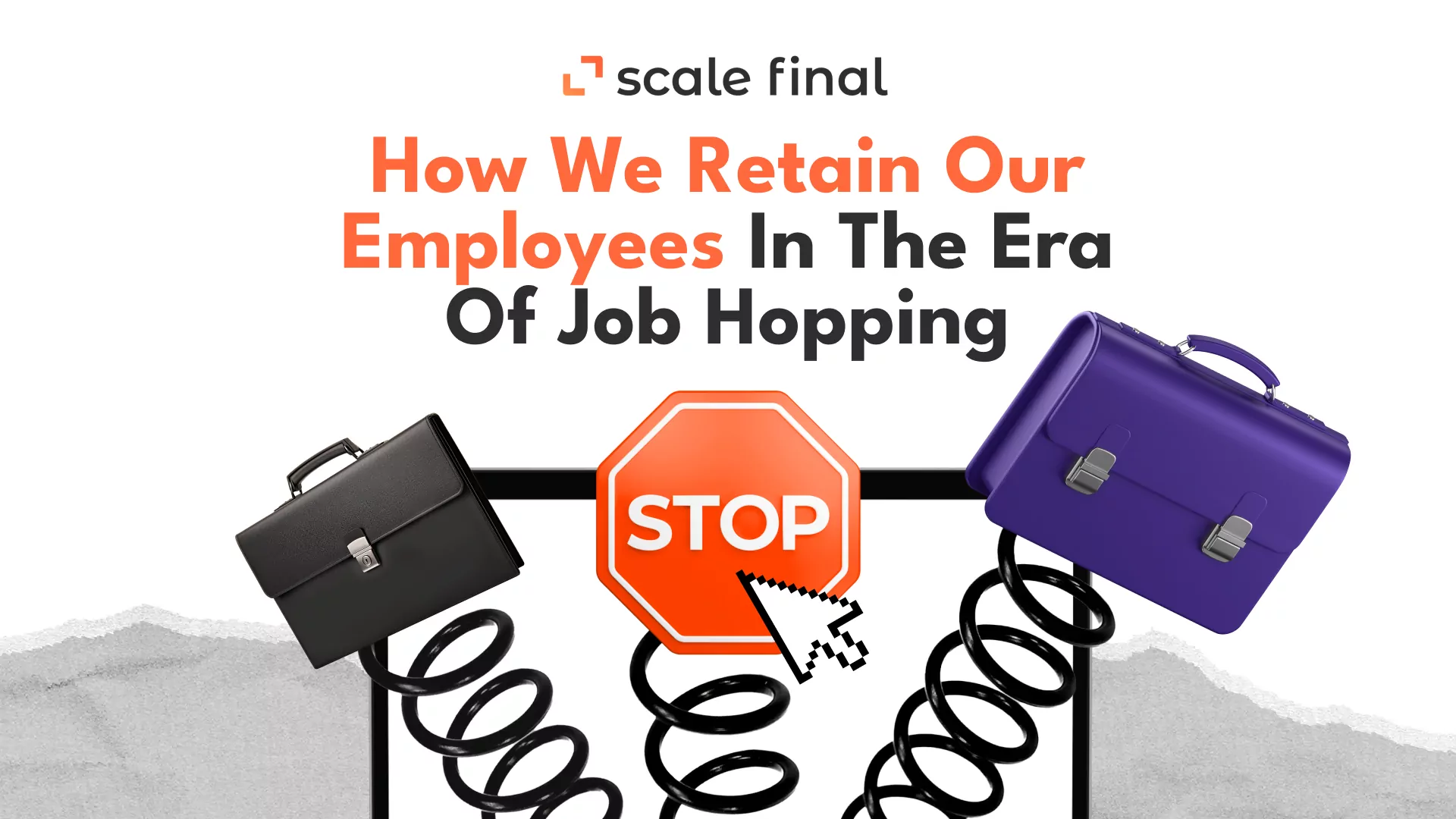
How we retain our employees in the era of job hopping
January 15, 2024Company
Job hopping is a big thing now. And at a time of global uncertainty. Yes, I’m talking to you, my Millennials and GenZ friends. Is it because of the short attention span? Or is it because we seek a place and people we feel comfortable with and can grow with? According to Zippia, on average, a millennial stays at their job for max 2.75 years. And most are torn between jobs, side hustles, or freelancing, which further disperses their professional experience. Even though GenZs didn’t have long before COVID-19, the IBM report found that Gen Z made up 33% of job hoppers in 2020. Of course, changing jobs is no longer a red flag for your future employers. But it’s always painful. Considering this uncertain era once again. We know how you must feel. We at Scale Final have found a secret to staying together. The team has been around for 4.5 years. And how? Building long-term relationships and treating people as personalities rather than functions is in our DNA, part of our core values. To keep it real, I talked to our HR Kate, who has seen it all (I’m only a newbie with only 1.5 years on the job). So here’s the interview. How come the team is 4.5 years old? We have a team that has been with us for 4.5 years. They have already changed 5 projects, and 2 weeks ago, they were transferred to a new project. The guys are talented and hardworking. It’s just that the project didn’t go well. Sometimes it’s the projects that don’t work, not the people. We never let our people down. There’s always something to do in our company. How do we not let people down? We have a girl joining us on January 8th for the Head of Media Buying position. She started 4.5 years ago as a junior. She grew very quickly, and we didn’t even have a promotion system for this project. When the project was closed, she left. But now she’s back, and we’re very happy about it! And this isn’t just one such example… I don’t want to take away people’s agency. Unless we’re talking about extreme situations, when a project is completed, or a person decides to leave the team, it is always their own decision. Their ideas, wishes, ambitions. Our co-founders listen to everyone and give everyone a chance. Scale Final isn’t about verticals. The people in the company move in all directions. People want to stay with the company. Senior management encourages people to grow even if they feel like exploring new areas. So there’s this Great Glass Elevator. It can move in any direction – not just up and down, but sideways, slantways, and any other direction you can imagine. This reflects the non-linear growth in Scale Final, where progress and advancement are not limited to a single, upward trajectory. In Scale Final, employees can change roles and responsibilities and adapt to new challenges and opportunities as they arise. How does Scale Final retain employees and stay attractive? Of course we have bonuses and regular salary increases. It’s very important that an employee gets a fair return on their time investment. We try to review programmers’ salaries (if they’re were hired for junior positions) every six months and marketers’ salaries – once a year. Marketers get bonuses from the profits they personally bring in. But that’s about it. We can’t boast about giving shares in the company or anything else yet. Our mutual growth is also an important factor. Absolutely. I believe that such clear human values set our team apart from others. Which, of course, also come with material benefits. Thanks to the fact for example, that we have groups with different levels of English, for example, people from different departments and different roles communicate with each other and become closer. First and foremost as people. As you said so well, Scale Final is like Willy Wonka’s elevator. I haven’t even started on our parties yet… From what you say, it sounds as if the employees set the rules themselves We owe the fact that we have these values to our co-founders. Once we have found our people, we stay with them. But you are absolutely right that these values are only maintained, nurtured and strengthened thanks to the team. It is only in the hands of the management to create the right atmosphere. But it is the team that lives and breathes it.
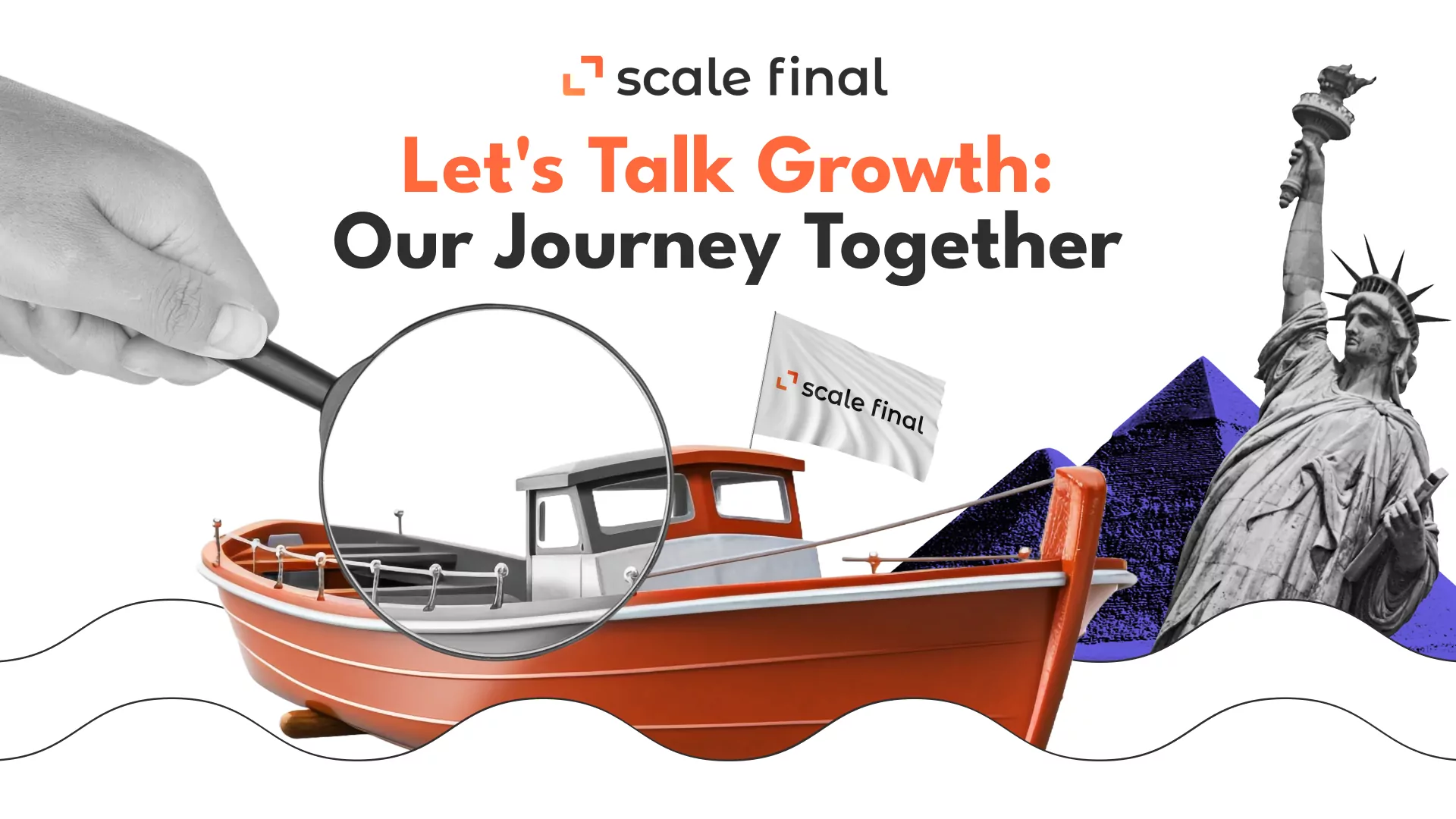
Let’s talk Growth: our journey together
December 26, 2023Company
One of our core values is growth. The word is overused and overly simplistic, but just the surface. In our case, growth is actually rich and profound. This motto fits the bill: “Your growth is our growth.” This isn’t talk about corporate advancement. We’re talking about real, meaningful progress for everyone on our team, from the founders to our newest employees and even the plants in our office. In this post, you’ll learn how we talk about growth. Quick disclaimer. Our approach to growth is multifaceted: from conferences to courses to company-paid training. Investing in continuous learning Tailored training for developers If you’re a developer with us, you can expect some serious upskilling. We don’t just pick and choose courses, we tailor them to your needs and take you further. That’s why we offer courses to those who have been with us for over a year, chosen in consultation with the team leads. This commitment to continuous learning ensures that our team members are always at the cutting edge of technology and best practice. From textbooks to e-courses There were days when we stacked textbooks in the Kyiv office. Those were good times, but we’ve moved on. Now we run online courses every six months. This ensures that everyone has access to the latest knowledge and skills, as we work remotely and from all parts of the world. Fostering language skills Communication is the key. We offer online English courses twice a week in 3 groups, depending on language level. This not only improves our team’s ability to communicate with international clients, but also promotes personal growth and self-confidence. And for some, it can be a gateway to interpersonal communication. After all, Scale Final is the international team. Adaptation and training for newcomers Onboarding should never be underestimated. For both sides. While we’ve always strived to find like-minded professionals, it’s difficult to familiarize yourself with the company culture, team dynamics, workload, etc. Therefore, we have developed a comprehensive training and adaptation program for new employees in various projects. Aside from the fact that every member clearly benefits from the time saved (yes, you spend some time putting your experience into some guides, but isn’t that helpful to you?), it’s a great benefit to the company because it underscores the motto that Scale Final is greater together than the sum of its parts. Conference participation: learning through exposure Okay, let’s talk about conferences. At the moment, it’s our affiliate managers who are traveling the world – Malta, Cyprus, and the next stop is London. But it’s not just a free vacation. It’s part of their job to network and find customers. They represent us out there, learn, make contacts and bring back ideas that help us move forward. And yes, we pay for everything: tickets, flights, hotels, and even cab rides. This provides invaluable learning opportunities and shows that we invest in the professional development of our employees. Why we do all this You might be wondering why we’re going to all this trouble? Well, because we’ve seen the results. As our team grows, the energy is different. The ideas flow better. The projects become more exciting. And then we all blossom. Not just as professionals but as a community. Join us on this journey So this is our story about growth. It’s not a buzzword for us, it’s a commitment. We’re on this exciting journey together, and every step we take is to ensure that we all grow, learn and succeed together. Stay tuned for more stories, more updates, and more growth. Because at the end of the day, we’re not just building a company. We’re building a community where everyone can shine.
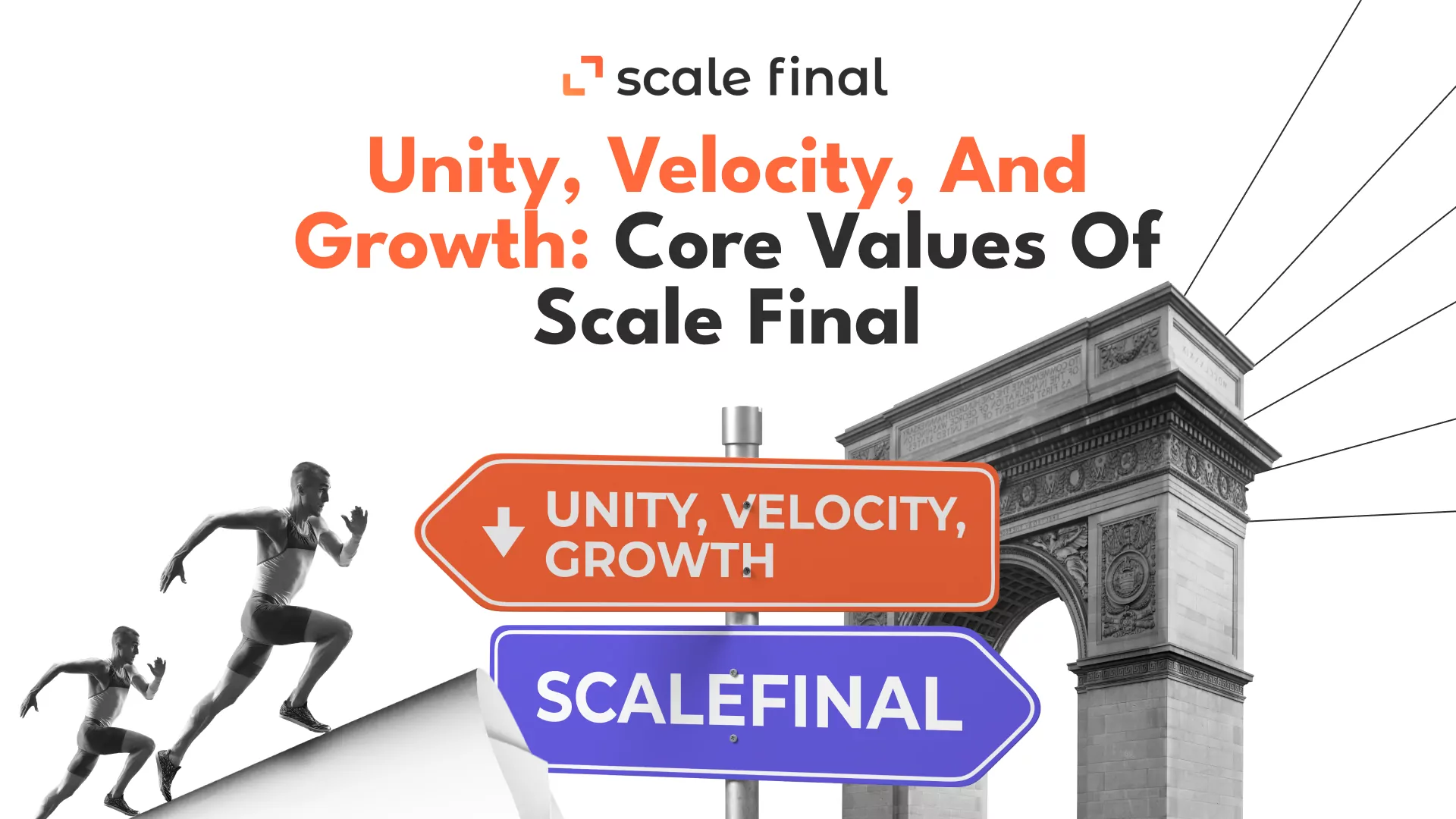
Unity, Velocity, and Growth: core values of Scale Final
December 8, 2023Company
We have more to say about our inner kitchen. The fact that we can finally put our shared values into words is a blessing in itself. As our CEO emphasized on LinkedIn, the team is each other’s most valuable asset. Let this post be a reminder to do the same for your team (yes, values are just as important as market research results) or just another post for you who want to become a part of Scale Final. Unlike the previous post of 6 reasons not to work at Scale Final, this post is about why you absolutely should. Those 6 reasons are somewhat controversial – each of them comes with a challenge. Values we’ll talk about now: Unity, Velocity, and Growth are our strongest points. These 3 values are our essence summarized in one word, which we formulated at our very beginning. They guide us in everything we do. And they will continue to guide us in the future. 1. Unity. This motto stands for loyalty and a strong sense of community. It is not only important to attract people with a competitive salary etc., but also to nurture relationships and build long-term commitments. In our daily work as a B2B company, we have met with many projects. We built many lasting relationships. But we also built up our team. Practice has shown that the people we have hired are always willing to learn and genuinely interested. That’s why we treated projects like projects for our people. We aligned them with the passions and skills of our team members. For this to really work in the long term, we need to be flexible. If a project needs a new perspective or new skills, we don’t shuffle people around, we bring the project to the person whose heart beats for it. Sometimes people move from one department to another because they want to acquire new skills. We work together because we don’t treat each other as functions, but as personalities. This approach has fostered a sense of belonging and loyalty that is rare in today’s fast-paced corporate world. Our team is not made up of interchangeable parts. Rather, it is a mesh of unique talents and passions that together create something greater than the sum of its parts. 2. Velocity. This motto emphasizes speed and agility, especially compared to the fast-paced world. In a world that moves at breakneck speed, our ability to learn, test, adapt, and deliver sets us apart. Like many others, we have felt the full force of the storm. Fortunately, we have learned to weather it like the perfect storm. This speed wouldn’t be so easy to achieve if we weren’t united. Take the crypto market, for example, which is known for its volatility and rapid changes. At Scale Final, we reflect this speed in our operations. We don’t just keep up, we have learned to set the pace. This agility is the result of our commitment to continuous learning and innovation. Whether it’s introducing new technologies or picking up on emerging market trends, our team is always at the forefront. 3. Growth “Growth” is the ideal word to summarize our focus on development and progress. Growth at Scale Final is holistic. It’s not just about the bottom line; it’s about the growth of our people, from the founders to the newest employees and even the plants in our office. We believe that the professional, financial and personal development of our team members is paramount. This belief is embedded in every aspect of our work life, from training programs to mentoring, to ensure that everyone grows together. Our success as a company is a direct reflection of the growth of our employees. When they do well, we do well. So as not to sound empty, look at what we mean by growth (from paid training to conferences and courses): Let’s talk Growth: our journey together
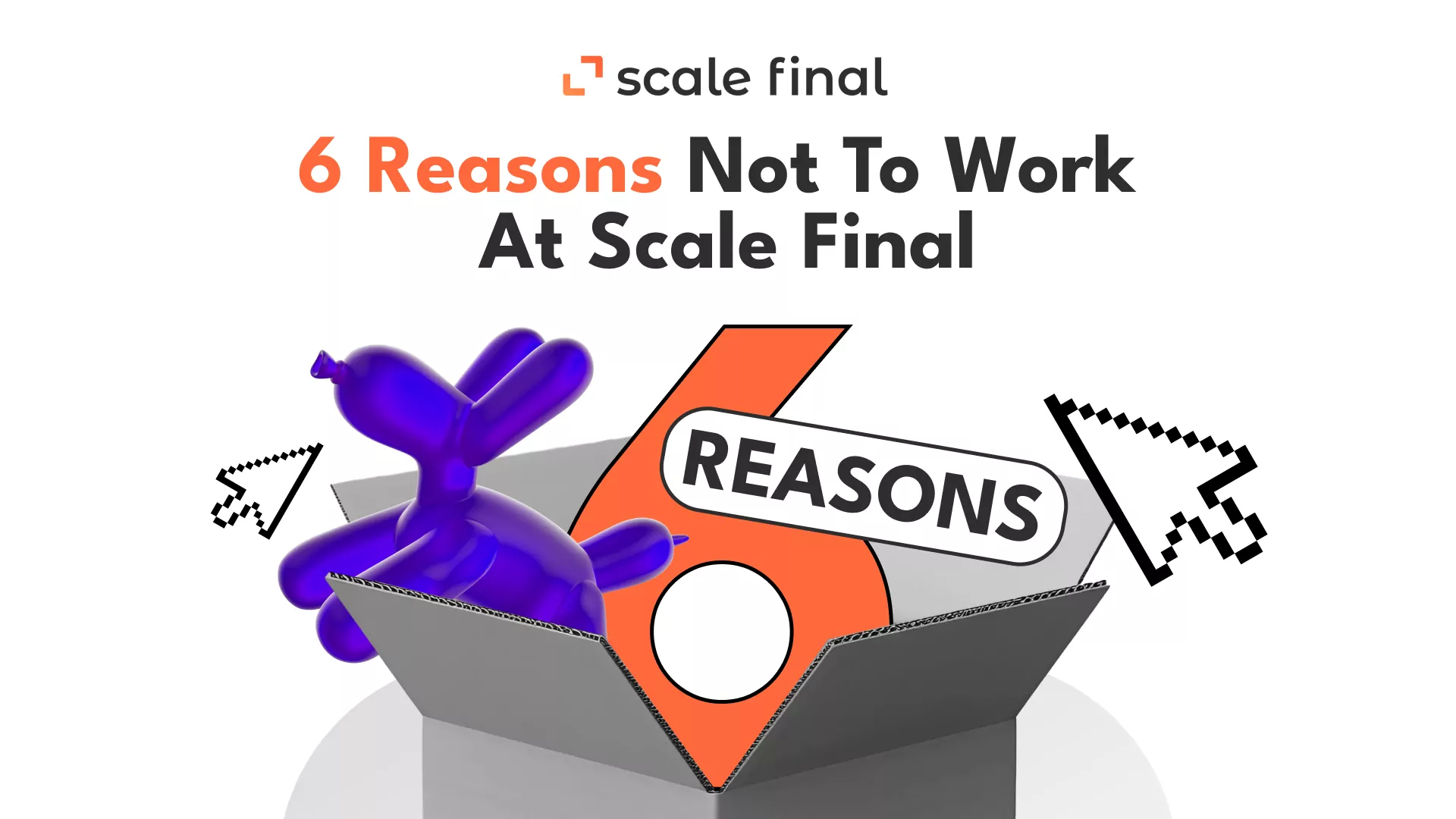
6 reasons not to work at Scale Final
November 28, 2023Company
It’s time for us to tell you more about our team and our company values. You can consider this text our manifesto if you want to become part of our team (we are almost ALWAYS hiring), or you can save the list and use it as a guide for your current team. At Scale Final, we pride ourselves on our strong values and work culture but recognize that our environment is not for everyone. If this doesn’t appeal to you, here are 5 reasons not to work with us. To summarize, Scale Final thrives on flexibility, fast pace, autonomy, startup vibes, constant learning, and risk-taking. Let’s dive in. 1. Flexibility over structure The world is constantly changing, and ignoring that is like an illusion. Routines and strict structures are only good for setting an example, but that’s not how things usually work in our daily lives. Why treat work as something fundamentally different from daily life? However, if you’re comfortable with predictability and fixed routines, our flexible approach might feel confusing. 2. Fast pace of development Our projects move at lightning speed. Team members usually start the day with one task and end it with a completely different one. This wouldn’t be so easy if we didn’t believe in incremental work. That’s why we work in sprints, where we cut the tasks into smaller pieces until nothing more can be done. This requires us to think quickly and adapt. Those who prefer a more leisurely, slow-paced work environment might find our rapid progress stressful and unsustainable. 3. High autonomy and self-direction Of course we have bosses. But they are actually there to manage you and sometimes help you. They’re not there to do the work with your hands. At Scale Final, everyone is their own boss. That means you have no bad guy in the office because you’re in charge and set the deadlines and hardships yourself. Although this offers freedom, it also requires high self-motivation and initiative. If you thrive under close supervision and clear, consistent instructions, our high autonomy culture might be challenging. 4. Startup vibe As a startup, we are always on our toes and ready to take on new challenges. This includes changing roles and responsibilities. This means that constant learning and dealing with uncertainty are essential. If you’re looking for a stable, predictable work environment, our constant evolution is not for you. 5. Constant learning This constant learning is exciting. Just like in daily life, you learn new things every day and how to do those things differently. But this also be daunting. It’s a challenge, especially when you learn that you didn’t do your best before. No one will stop you from changing your specialty and stepping into the unknown at Scale Final. If you prefer to have a clear area of expertise without having to regularly venture into the unknown, our culture of endless learning and exploration may not suit you. 6. Risk-taking It’s part of our DNA. You’ll never learn anything if you don’t leave your comfort zone and try something new/unusual. We don’t just encourage taking risks, we celebrate them. This will only take us so far. It requires us to be comfortable with change and have a high tolerance for failure. Our risk-taking goes hand in hand with the need to make quick decisions. If you find setbacks particularly daunting or prefer a more guaranteed course of success, our approach to risk and failure may be too overwhelming for you. Join us We publish open positions on our LinkedIn page. Follow us so you don’t miss any important news. We’re currently looking for a Financial Data Analyst. Another vital source of news is the page of our CEO Sviat Pinchuk.




